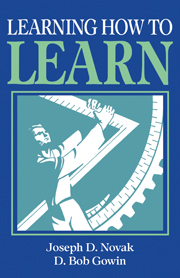Book contents
- Frontmatter
- Contents
- Foreword
- Preface
- Acknowledgments
- 1 Learning about learning
- 2 Concept mapping for meaningful learning
- 3 The Vee heuristic for understanding knowledge and knowledge production
- 4 New strategies for instructional planning
- 5 New strategies for evaluation: concept mapping
- 6 The use of the Vee for evaluation
- 7 The interview as an evaluation tool
- 8 Improving educational research
- Appendixes
- References
- Index
Foreword
Published online by Cambridge University Press: 05 June 2012
- Frontmatter
- Contents
- Foreword
- Preface
- Acknowledgments
- 1 Learning about learning
- 2 Concept mapping for meaningful learning
- 3 The Vee heuristic for understanding knowledge and knowledge production
- 4 New strategies for instructional planning
- 5 New strategies for evaluation: concept mapping
- 6 The use of the Vee for evaluation
- 7 The interview as an evaluation tool
- 8 Improving educational research
- Appendixes
- References
- Index
Summary
During the past year two aspects of my life have often been juxta-posed. As president of a national teaching association, I have served on state and national commissions concerned with clarifying the crises in science education and I have traveled the country discussing the identified crisis with classroom teachers. As a science educator concerned about how students, particularly female and minority students, learn, I have assessed and analyzed learning among black teenagers who used the constructs described within this book. What amazes me in retrospect is how and why those two activities were so separate, so distinct. Surely the first concern of the prestigious commissions and researchers, as well as the journalists who publicized their work, was how children learn. Yet neither in the headlines nor in the footnotes did I find references to meaningful learning – to education. Rather, I read about training, testing, disciplining, and employing. Yet, shouldn't the science education of the children in my research help them think about the consequences of using a nuclear weapon as well as teach them how to read the operational manual and run the machine?
As the hoopla concerning the crisis fades and the work of rejuvenating education begins, I suggest that parents, teachers, administrators, and researchers read this book. It succinctly and clearly presents a view, a theory, of how children learn and, therefore, how teachers and others can help children think about science as well as other topics.
- Type
- Chapter
- Information
- Learning How to Learn , pp. ix - xPublisher: Cambridge University PressPrint publication year: 1984



